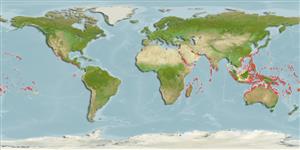Classification / Names
Common names from other countries
Main reference
Size / Weight / Age
Max length : 6.5 cm TL male/unsexed; (Ref. 11344)
Environment
Marine; reef-associated; depth range 1 - 20 m (Ref. 9710)
Climate / Range
Tropical, preferred ?; 30°N - 32°S
Distribution
Indo-Pacific: Persian Gulf (Ref.80050) and Red Sea to the Hawaiian, Line, and Tuamoto Islands, north to southern Japan, south to Lord Howe and Rapa.
Countries | FAO areas | Ecosystems | Occurrences | Introductions
Short description
Dorsal
spines
(total): 7;
Dorsal
soft rays
(total): 9-11;
Anal
spines: 1;
Anal
soft rays: 8 - 9. Body tan to black in color with light spots; midside with small elongate dark spots; short vertical bars or saddles above (Ref. 2798); characterized further byprolonged third dorsal spine , forms long filament in adult; longitudinal scale series 23-25; ctenoid scales; head scaled except snout and interorbital space; 3-9 close-set spines on edge of preopercle just above the corner; rounded caudal fin; depth of body 3.0-3.6 in SL (Ref. 90102).
IUCN Red List Status (Ref. 115185)
Threat to humans
Harmless
Human uses
Aquarium: commercial
More information
ReferencesAquacultureAquaculture profileStrainsGeneticsAllele frequenciesHeritabilityDiseasesProcessingMass conversion
Tools
Special reports
Download XML
Internet sources
Estimates of some properties based on models
Phylogenetic diversity index
PD50 = 0.5039 many relatives (e.g. carps) 0.5 - 2.0 few relatives (e.g. lungfishes)
Trophic Level
2.4 ±0.00 se; Based on food items.
Resilience
High, minimum population doubling time less than 15 months (Preliminary K or Fecundity.)
Vulnerability
Low vulnerability (14 of 100)
Price category
